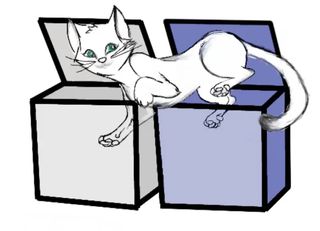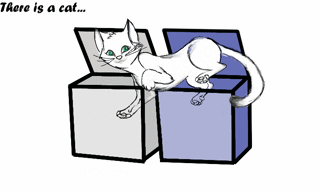
Bizarrely behaving light particles show that the famous Schrödinger's cat thought experiment, meant to reveal the strange nature of subatomic particles, can get even weirder than physicists thought.
Not only can the quantum cat be alive and dead at the same time — but it can also be in two places at once, new research shows.
"We are showing an analogy to Schrödinger's cat that is made out of an electromagnetic field that is confined in two cavities," said study lead author Chen Wang, a physicist at Yale University. "The interesting thing here is the cat is in two boxes at once." [What's That? Your Physics Questions Answered]
The findings could have implications for cracking unsolvable mathematicalproblems using quantum computing, which relies on the ability of subatomic particles to be in multiple states at once, Wang said.
Cat experiment
The famous paradox was laid out by physicist Erwin Schrödinger in 1935 to elucidate the notion of quantum superposition, the phenomenon in which tiny subatomic particles can be in multiple states at once.
In the paradox, a cat is trapped in a box with a deadly radioactive atom. If the radioactive atom decayed, the cat was a goner, but if it had not yet decayed, the cat was still alive. Because, according to the dominant interpretation of quantum mechanics, particles can exist in multiple states until they are measured, logic dictated that the cat would be both alive and dead at the same time until the radioactive atom was measured.
Cat in two boxes
The setup for the new study was deceptively simple: The team created two aluminum cavities about 1 inch (2.5 centimeters) across, and then used a sapphire chip to produce a standing wave of light in those cavities. They used a special electronic element, called a Josephson Junction, to superimpose a standing wave of two separate wavelengths of light in each cavity. The end result was that the cat, or the group of about 80 photons in the cavities, was oscillating at two different wavelengths at once — in two different places. Figuring out whether the cat is dead or alive, so to speak, requires opening both boxes.
Sign up for the Live Science daily newsletter now
Get the world’s most fascinating discoveries delivered straight to your inbox.

Though conceptually simple, the physical setup required ultrapure aluminum and highly precise chips and electromagnetic devices to ensure that the photons were as isolated from the environment as possible, Wang said.
That's because at large scales, quantum superposition tends to disappear almost instantaneously, as soon as these superimposed subatomic particles whose fates are linked interact with the environment. Most of the time, this so-called decoherence would happen so quickly that researchers would have no time to observe the superposition, Wang said. So devices that keep coherence (or keep the particles in superposition) for long periods of time, known as the quality factor, is extremely important, Wang added.
"The quality of these things determines once you put a single excitation into the system, how long does it live, or does it die away," Wang told Live Science.
If the excitation of the system — the production of the electromagnetic standing wave — is similar to the swing of a pendulum, then "our pendulum swings essentially tens of billions of times before it stops."
The new findings could make for easier error correction in quantum computing, Wang said. In quantum computing, bits of information are encoded in the fragile superposition states of particles, and once that superposition is lost or corrupted, the data is also corrupted. So most quantum computing concepts involve a lot of redundancy.
"It's well understood that 99 percent of computation or more will be done to correct for errors, rather than computation itself," Wang said.
Their system could conceivably get around this problem by encoding the redundancy in the size of the cavity itself rather than in separate, calculated bits, Wang said.
"Demonstrating this cat in a 'two boxes state' is basically the first step in our architecture," Wang said.
Follow Tia Ghose on Twitterand Google+. Follow Live Science @livescience, Facebook & Google+. Original article on Live Science.

Tia is the managing editor and was previously a senior writer for Live Science. Her work has appeared in Scientific American, Wired.com and other outlets. She holds a master's degree in bioengineering from the University of Washington, a graduate certificate in science writing from UC Santa Cruz and a bachelor's degree in mechanical engineering from the University of Texas at Austin. Tia was part of a team at the Milwaukee Journal Sentinel that published the Empty Cradles series on preterm births, which won multiple awards, including the 2012 Casey Medal for Meritorious Journalism.
Most Popular


